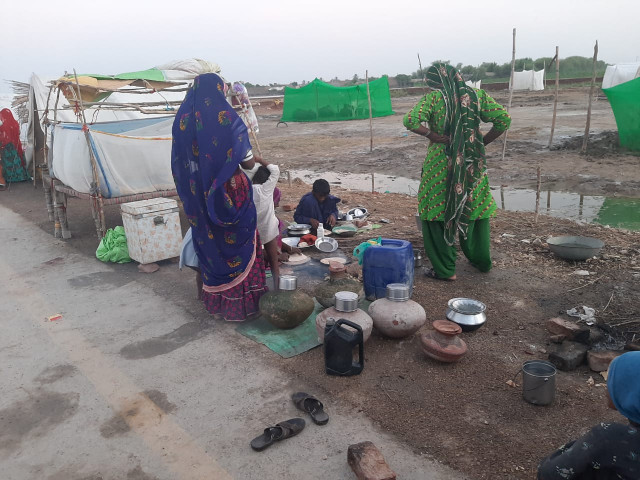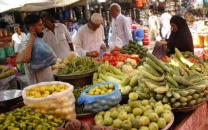Food crisis feared in Sindh
Farmers say floods washed away up to 80% crops; prices likely to go up due to shortage

The deadly floods in Sindh have not only ravaged the infrastructure of the province but also damaged the crops, triggering fears of economic losses and food security issues in the coming days.
The government has yet to assess the losses, but a representative of the farmers’ community told The Express Tribune that “80 per cent of the cotton crop” was ravaged, while “60-70 per cent of rice, 80 per cent onion, tomatoes and chilies, and 80 per cent dates” were washed away.
There are three barrages in Sindh that irrigate land. Sukkar Barrage provides water to around 10 million acres, Kotri Barrage 2.4-3.3 million acres and Guddu Barrage irrigates 900,000 to 1.7 million acres.
“This year cotton was sown on around 1.38 million acres in Sanghar, Ghotki, Nawabshah, Khairpur Mir’s, Hyderabad, Dadu and Naushehro Feroze, where hardly 10-15 per cent crop was harvested,” Sindh Chamber of Agriculture Senior Vice President Nabi Bux Sahito said.
He said that the estimated rice sowing targets for 2022 were 1.7 million acres, fearing that 60 per cent of the crop might be damaged.
“In lower Sindh, the paddy was about to be harvested, which can partially be damaged, but in upper Sindh, the crop standing on 900,000 acres was being sowed, which will now be badly affected,” he added.
Ishaq Soomro, a rice farmer in Kamber Shahdadkot district, while sharing his ordeal, said that he had sown the paddy on 100 acres, with the per acre cost being Rs30,000.
“A breach developed in the canals washed away all the crops, leaving 5 to 6 feet of water on my land,” he said. “We have lost all hopes for the Kharif crop and will only be able to harvest the Rabi crop if the water recedes.”
The farmers were of the view that as chili and other kinds of vegetables were completely damaged, there could be a severe shortage.
According to official figures, onions are produced on around 1.5 million acres in different districts of Sindh. The recent flood has wreaked havoc on the crop.
“In the coming days, you will see exorbitant prices of tomatoes, onions and chilies, etc. It will take two to three months for growers to cultivate and supply vegetables to the market,” Sahito said.
Sindh Abadghar Board leader Syed Mehmood Nawaz said that the dates were mature when the rain descended. “Around 80 per cent of the fruit could have been saved if we had a better infrastructure,” he said, adding that cauliflower was lost as well.
He said that sugarcane and rice had also been impacted despite the fact that they benefitted from rains, but the duration of standing water led to a negative impact.
According to Peddu Mal, who is associated with the cotton ginning business, the shortage of cotton in Sindh would hurt the textile industry as well. “The export of textiles and clothing earned around $15 billion in the first 10 months of this year,” he said, adding that the textile and related industries showed growth in April.
He predicted that most of the ginning factories would be closed in the coming days as well and hundreds of employees laid off.
“There are 100 cotton factories alone in Sanghar district … how we can run ginning factories if there is no cotton?” he asked, adding that they would have to wait for another season.
He said that they also paid millions of rupees in taxes, which too would come down as the factories were closed.
Nawab Zubair Talpur, a landlord who lost his standing crops on hundreds of acres, demanded of the government to waive off agriculture loans and announce cash support to small and medium farmers.
“Growers cannot afford to cultivate land until they are given the incentives,” he said.
According to Red Chili Growers Association, this year red chili was cultivated at around 35,000 acres in Umerkot, Mirpurkhas and Sanghar districts, and around 80-85 per cent of the crop was damaged.
“Only 15 to 20 per cent of those areas remained safe, which were located on the dunes,” Mian Saleem, the president of the association, said. “We were expecting 40,000 tonnes of red chili production this year, but after this devastation, the production will reduce to 5,000 to 6,000 tonnes.”
He added that two years ago, red chili used to be cultivated on 80,000 acres in Sindh, which had now reduced to 35,000 acres. He attributed this to a viral attack that stunted the crop’s growth.



















COMMENTS
Comments are moderated and generally will be posted if they are on-topic and not abusive.
For more information, please see our Comments FAQ